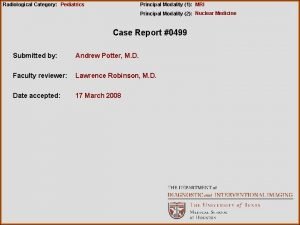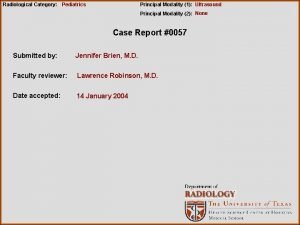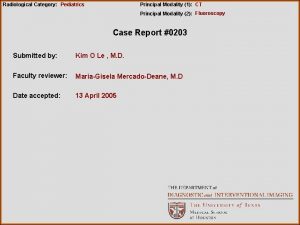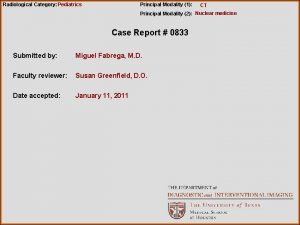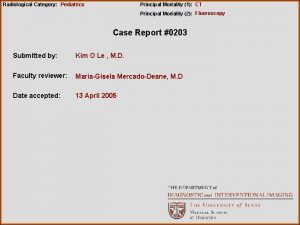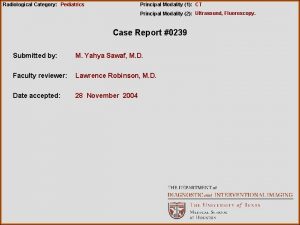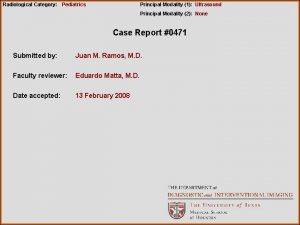Radiological Category Pediatrics Principal Modality 1 CT Principal












- Slides: 12

Radiological Category: Pediatrics Principal Modality (1): CT Principal Modality (2): Ultrasound Case Report # 0010 Submitted by: Edwin Rodriguez, M. D. Faculty reviewer: Christopher I. Cassady, M. D. Date accepted: 18 June 2003 No previous presentation or publication (Original Case).

Case History 3 year-old female patient with palpable abdominal mass.

Radiological Presentations Fig. 1. - Transverse sonographic view at the level of hepatic venous confluence, showing ascites and thrombosis of the right hepatic vein and inferior vena cava.

Radiological Presentations Fig. 2. - Transverse sonographic view of the left kidney showing a large mass almost entirely replacing the left renal parenchyma.

Radiological Presentations Fig. 3. - Axial Post-contrast CT image of the abdomen confirms the presence of a large mass involving the left kidney. Observe thrombosis of the left renal vein extending into the IVC. No contralateral renal mass or adenopathy was noted.

Radiological Presentations Fig. 4. -Post-contrast CT showing thrombosis of the IVC, with perfusion abnormality corresponding to the drainage distribution for the RHV. Note ascites as identified on ultrasound examination.

Radiological Presentations Fig. 5. -Thrombus in the inferior vena cava extends superiorly into the right side of the heart. Large bilateral pleural effusions are also present.

Test Your Diagnosis Which one of the following is your choice for the appropriate diagnosis? After your selection, go to next page. • Nephroblastoma (Wilm’s tumor) • Mesoblastic nephroma • Lymphoma • Rhabdoid Tumor of the Kidney • Renal cell carcinoma • Clear cell sarcoma of the kidney • Neuroblastoma

Findings and Differentials Findings: Large, necrotic, soft tissue mass replacing almost the entire left renal parenchyma with tumor thrombus in the left renal vein, IVC, right hepatic vein and right atrium. Bilateral pleural effusions are also present. No contralateral masses, adenopathy or lung metastases were noted. Differential diagnosis: • Nephroblastoma (Wilms’ Tumor) • Rhabdoid tumor of the kidney • Clear cell sarcoma of the kidney • Renal Cell Carcinoma

Discussion Wilms’ tumor is the most common solid abdominal mass in the pediatric population, and the most common renal malignancy in childhood. It has a peak incidence between 2. 5 to 3 years of age, with 80% of the cases presenting between 1 and 5 years of age. It contains epithelial, blastemal and stromal elements, and is bilateral in approximately 5 -10% of the cases. Prognosis is strongly related to the tumor histology. Approximately 90% have favorable histology, with anaplastic type (3 -10%) having the worst prognosis. Renal vein extension helps explain the high rate of hematogenous metastasis at diagnosis. Survival rate for synchronous tumors is approximately 87%, versus 40% for metachronous tumors. Calcification can be seen by CT in up to 15% of the cases. Based on frequency and vascular invasion, Wilms’ tumor would be the most likely diagnosis. Although it is also associated with vascular invasion, Renal cell carcinoma is not common in this age group, unless associated with syndromes (e. g. Tuberous sclerosis). In addition to being less common, Rhabdoid tumor and Clear cell sarcoma of the kidney do not have the same propensity for vascular invasion.

Discussion References: • Kirks DR, Practical pediatric imaging: diagnostic radiology of infants and children, 3 rd ed. Philadelphia: Lippincott-Raven, 1998: 1111 -1126 • Lowe LH, Isuani BH, Heller RM, et al: Pediatric renal masses: Wilms tumor and beyond. Radio. Graphics 2000; 20: 1585 -1603 • Coppes MJ, Arnold M, Beckwith JB, et al: Factors affecting the risk of contralateral Wilms tumor development: a report from the National Wilms Tumor Study Group. Cancer 1999 Apr 1; 85: 1616 -1625

Diagnosis Final Histologic diagnosis: Nephroblastoma (Wilm’s tumor)
 E-rate category 1 vs category 2
E-rate category 1 vs category 2 Tennessee division of radiological health
Tennessee division of radiological health Center for devices and radiological health
Center for devices and radiological health National radiological emergency preparedness conference
National radiological emergency preparedness conference Radiological dispersal device
Radiological dispersal device Modality
Modality Low modality examples
Low modality examples Pacs modality workstation
Pacs modality workstation Short wave diathermy definition
Short wave diathermy definition Sensory vs somatic
Sensory vs somatic Epistemic modality
Epistemic modality Sodality vs modality
Sodality vs modality Cardinality and modality
Cardinality and modality















